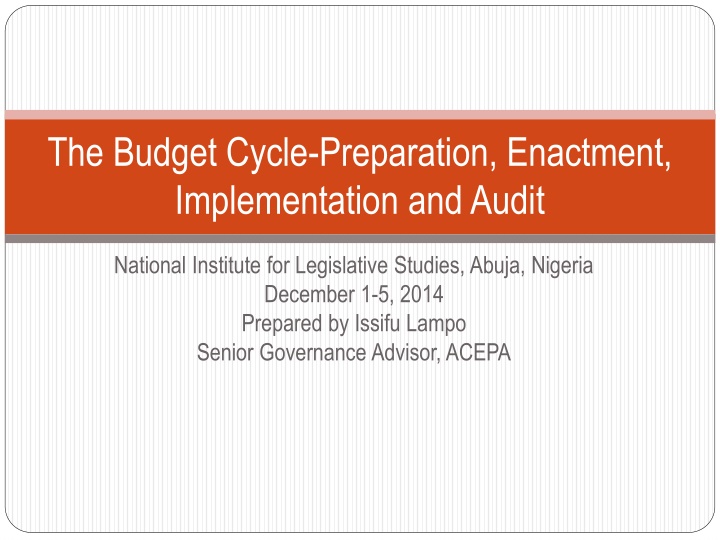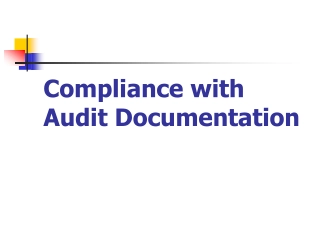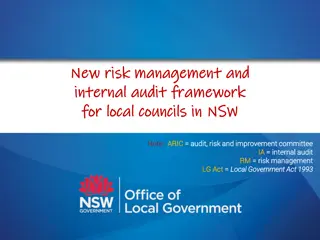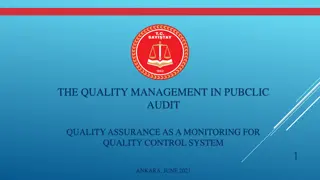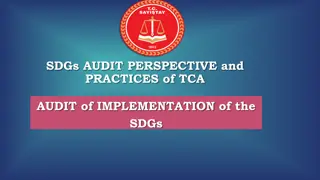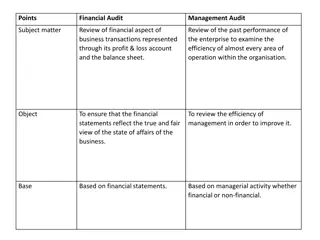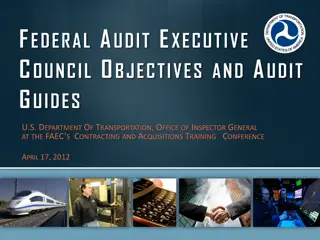The Budget Cycle-Preparation, Enactment, Implementation and Audit
In this presentation, delve into the intricate stages of the budget cycle - from preparation to execution and audit. Explore the nuances of budget formulation, authorization, and accountability in national financial management. Understand the significance of revenue, expenditure, domestic revenue, foreign aid, and types of government spending. Gain insights into how government budgets shape public expenditure.
Download Presentation

Please find below an Image/Link to download the presentation.
The content on the website is provided AS IS for your information and personal use only. It may not be sold, licensed, or shared on other websites without obtaining consent from the author.If you encounter any issues during the download, it is possible that the publisher has removed the file from their server.
You are allowed to download the files provided on this website for personal or commercial use, subject to the condition that they are used lawfully. All files are the property of their respective owners.
The content on the website is provided AS IS for your information and personal use only. It may not be sold, licensed, or shared on other websites without obtaining consent from the author.
E N D
Presentation Transcript
The Budget Cycle-Preparation, Enactment, Implementation and Audit National Institute for Legislative Studies, Abuja, Nigeria December 1-5, 2014 Prepared by Issifu Lampo Senior Governance Advisor, ACEPA
Outline of Presentation Definition of the budget Overview of the National Budget: Stage 1 Formulation/Preparation Stage 2 Authorization (legislation appraisal and debate on Executive Budget and supporting legislation) Stage 3 Budget Execution (implementation, monitoring and control Stage 4 Accountability (public audit, review, reporting and assessment of effective implementation
Introduction contd What is a budget? -It is a Statement of expected income and expenditure over a specified period of time, say a year. The public budget is the income and expenditure of a government. -A budget is a planning tool-it matches expected revenue and expenditure, and provides details of the choices government makes with regards to revenue collection and expenditure
Introduction contd - Basically, the budget is about how the Government will collect and spend our money-allocating to projects according to his priorities. -The budget basically has two main sections; Revenue and Expenditure. -Government gets money from two main sources-domestic revenue and foreign aid
Introduction contd -Domestic revenue refers to revenue that is raised within the borders of a country-from taxes paid by citizens, duties on imports, profits from privatization, and various other fess, like driving licenses, road tolls etc -Foreign aid refers to financial assistance from foreign governments and multilateral institutions like WB, IMF, Governments from other countries
Introduction contd -Loans and Grants- sometimes, we also go for loans and we receive grants, and how it is monitored and reported Budget explains how government intends to spend the money collected Two main types of expenditure -Recurrent expenditure-spending that occurs on an annual basis, like salaries of government workers, running cost of ministries, vehicles etc
Introduction contd -Development spending-spending on infrastructure and other investments that do not necessarily recur each year e.g. roads, schools, hospitals etc. -Analyzing expenditure is critical for analyzing Government s priorities, or choices-since the amount of money that can be raised from domestic revenue and foreign aid is limited, the Government must choose how and where to spend it
Overview of the National Budget Process Formulation Stage: 1. -formulation of budget policy, resource projections -issuance of planning and budget guidelines -estimating revenues and expenditure by MDAs, -scrutiny of estimates by Parliament s sub-committee and inter- ministerial technical committee (not applicable to all parliaments, ) -cabinet approval of budget estimates
Overview of the budget process contd 2. Debates andApproval: -tabling in Legislation (Parliament) -budget day -debate in full Parliament -budget voted into law (Appropriation act Passed) 3. Budget Execution: -MDAs prepare action plans
Overview of the budget process contd -budget is executed by cash budget system -central government releases money to states/regions, districts/counties -services delivered 4. Oversight and Control -within year monitoring -external audit conducted by the Controller andAuditor General
Overview of the budget process contd -audit reports tabled in Parliament and follow-up action
Formulating/drafting stage (six-step MTEF Process) Step 1. Macroeconomic framework Macroeconomic model projecting revenues and over the medium-term (3yr), directives on sectoral ceilings and call for estimates 2. Development of Sectoral Pogrammes and development of Programmes and sub-programmes 3. Development of Sectoral Expenditure Framework strategic resource allocation 4. Defining of sector resource allocations 5. Preparation of sectoral budgets ceilings 6. Political approval Budget estimates presented to cabinet and then to Parliament for Approval Activity Agreement on Sectoral objectives and activities; review Analysis of inter-and intra-trade-offs and consensus on Negotiation of medium-term sector budget ceilings Medium-term sectoral programmes based on approved
Parliamentary Authorization Under the Constitution of ECOWAS member States, power to make laws is vested in the National Assemblies and Presidents/Head of States Parliament approves the AppropriationAct Central to the legislature s constitutional position is The Power of the Purse , i.e. its role as the ultimate authority that authorizes public expenditure budget and passes the
Presentation of the Budget to Parliament The Minister of Finance lays on the table of the National Assembly the following documents: -The Budget Speech -The Economic Report -The Financial Report -The Establishment Register
Presentation of the Budget to Parliament The National Assembly scrutinizes, appraises, debates, and approves estimates of revenue and expenditure The National Assembly approves estimates of revenue through its Committee of Ways and Means/Finance Committee (may differ in other jurisdictions) All expenditure allocations approved by whole House
Committees Enabling legislation for expenditure is through Appropriation Bills for supplementary and excess expenditure. Finance Committee/Expanded Committee on estimates review budget estimates on behalf of the whole House with input from Civil society attending meetings as witnesses All proposed amendments must be within budget Sectoral Parliamentary Committees also sift through budget estimates pertaining to their portfolios
Budget Execution After legislative approval of expenditures, there are six main stages in the spending process: 1. The authorization stage 2. The Commitment stage . 3. The Verification stage 4. Payment authorization or payment order stage 5. Payment stage 6. Accounting stage
The Sequence is as follows: Budget appropriations approved by Parliament Release of appropriations to spending ministries (as lump sum, or as quarterly or monthly allotments) Line ministries (spending agencies enter in contracts and orders commitments, and pay wages, pensions, etc weekly or monthly) Goods and services are delivered and verified Bills or invoices are received and payment orders prepared and issued
Sequence.. Payment is made via cash, cheque, or electronic transfer Transaction is recorded in accounts Accounts are audited
Problems in Budget Execution Typical problems are: Multiplication expenditure control arrangements Failure to reconcile bank statements with budget accounts thus difficult to obtain reliable and timely data on cash expenditures Accumulation of payment arrears Lack of fund consolidation of exceptional procedures bypassing
Accountability (public audit, review, report, assessment of effectiveness Auditor General s office is Supreme Audit Institution (SAI) in Member States Auditor General is responsible for ensuring accountability Public Audit Act spells out the Auditor General s roles as follows:
Auditor Generals roles Follows public funds whenever they are spent Auditor General holds Parliament and the citizens of member States for public expenditure of public funds Mandate, authority and protection for Auditor General to discharge duties clearly set out in Constitution government accountable to
AG roles contd Attests to integrity of government s financial accounts and expenditure AG is required to submit audit report to Parliament/President within .
Challenges and Conclusion Budget preparation and execution faces a myriad of challenges: Fiscal risks Difficulty to cop with uncertainty to ensure budget remains authoritative Cash constraints
Challenges and Conclusion Weaknesses in public expenditure management system: -overoptimistic revenue projections -under-budgeting in case of some expenditure items -poor expenditure control leading to domestic arrears -lack of budget discipline
